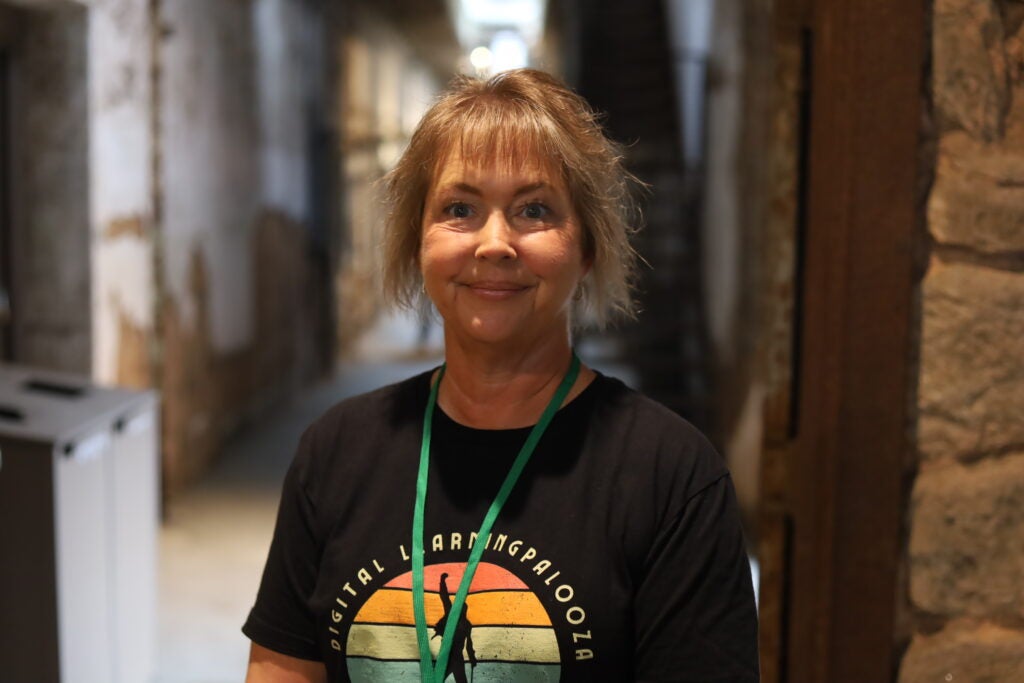Eastern State Penitentiary’s reentry simulation offers glimpse into post-incarceration challenges
Dozens of visitors to the Eastern State Penitentiary got to experience the challenges of acclimating to post-incarceration life.
Listen 1:10
Attendees navigate different tasks during the Eastern State Penitentiary’s Reentry Simulation on Saturday. (Carmen Russell-Sluchansky/WHYY News)
From Philly and the Pa. suburbs to South Jersey and Delaware, what would you like WHYY News to cover? Let us know!
Several dozen visitors gathered late Saturday morning within the Eastern State Penitentiary’s historic walls for a journey replicating reentering society after incarceration.
The event gave participants an immersive, role-playing experience that mirrors the struggles formerly incarcerated individuals face upon release. Participants were assigned fictional identities with rap sheets, housing and employment limitations and a checklist of critical tasks to complete such as finding a job, checking in with parole officers, securing transportation and paying rent. The program gave participants more than an hour to complete structured assignments.
Robyn Kelso, a teacher from Kansas, said she found the experience “overwhelming” but “powerful.” She was also “frustrated” navigating station to station trying to accomplish the assignments while attempting to stay out of “jail.”

“I think that word’s going to come up frequently,” she said. “I wasn’t expecting it to be as difficult as I’m finding it.”
If these walls could speak
The simulation was part of Eastern State Penitentiary’s Justice 101 series, an educational initiative that examines the history of the justice system in America, from its founding to today, and the impact it has on society, citizens and the world. The series includes discussions on topics such as solitary confinement, capital punishment and the prison industry, aiming to foster dialogue and understanding around complex criminal justice issues.
Eastern State Penitentiary was once the most famous and expensive prison in the world. In operation from 1829 until 1971, it was the first true “penitentiary” — a prison designed to inspire penitence among incarcerated people through solitary confinement and reflection. Its radial floor plan and innovative philosophy influenced prison design worldwide.
Today, the site operates as a nonprofit museum and historic site dedicated to educating the public about the history and legacy of mass incarceration, using its dramatic architecture and layered history to explore contemporary issues of justice and incarceration through exhibits and public programs like the Justice 101 series.

The simulation highlights how systemic barriers, such as lack of ID, employment discrimination and limited access to transportation, can derail a person’s attempt to reintegrate into society. Its goal is to demonstrate how the obstacles to a smooth transition to “life outside” can create challenges to live the life most people take for granted.
Real-life crisis simulated
At Saturday’s simulation, participants moved between stations manned by volunteers acting as landlords, employers, social workers and probation officers while jostling through the crowd that filled the former prison’s narrow hallways.
Many participants found themselves spending more time waiting in line than making progress — a pointed nod to the bureaucratic backlog many face in real life.
“I’m an educator. I want things to flow smoothly, which this is not, but I think that’s by design as well,” Kelso said as she navigated the crowd.
For the simulation, Kelso became “Laura,” who served 25 years for murder, felony possession of a firearm and a drug conviction. Laura had a high school diploma, $200 in savings and was working in a fast food restaurant while living with her boyfriend.
As Laura, Kelso first went to get her state ID since most of the tasks require three pieces of identification: a state ID, a birth certificate and a social security card.
“When I saw I didn’t have all three IDs on my life card, I thought I will be very surprised if I get all three IDs before this whole simulation ends,” she said.
She did manage to get her state ID, at a cost of $15, on the second try and just in time for “week one” to end.
“Laura” was not “successful” the first week, having accomplished only one goal. She also failed to eat, which participants were supposed to do each simulated week. However, she was more fortunate than some of the others. She lived with her boyfriend, while five others who failed to pay rent ended up at a shelter. Several wound up back in jail.
Next, Kelso made her way to the treatment center where “Laura” had to check-in given her drug conviction.
“Got to make sure I’m clean and sober, I guess,” Kelso mused. However, she didn’t know where the treatment center was and found herself jostling through the crowd going up and down the tables.
“Life happens”
After she finally found it and was standing in line, volunteers passed out “life cards,” which could be called “life happens cards” and represent unexpected developments. Kelso’s card said it was Laura’s mother’s birthday so she needed to go to the “supercenter” to get a gift.
However, soon after she checked in at the treatment center, and forked over another $15, time was up and the second week was over. That meant Kelso only accomplished two items on a list of 10. It also meant no gift for Mom.
“I guess I was supposed to drop what I was doing and go get a gift,” Kelso said.
Then “Laura” had to go in for her probation meeting. It didn’t go well because she missed her first probation meeting while trying to get her ID. That meant her next stop was court.
But that didn’t go well either. “Laura” was told to draw an “action card,” which instructed her to report to jail. Just then, week three ended.
When week four started, Kelso was out of transportation tickets which she used up going to her various appointments and she needed to buy more.
“I’m not even sure where to get those,” she said. “You would think I would have a mental map by now of where everything is, but I think I’m just so flustered that I’m not really focusing.”
Kelso eventually found the table with transportation tickets and then headed back to the treatment center. A little later, week four ended and the simulation was over.
Kelso reflected on the ordeal.
“I’m beginning to understand why the recidivism rate is so high,” she said. “It should not be this complicated. We live in the 21st century. So it feels like it’s intentionally set up to be a barrier for those who are coming out of incarceration.”
Pennsylvania is home to more than 37,000 incarcerated individuals in state facilities, and each year thousands are released into communities that are often ill-equipped to support them. As a result, many end up back in prison.
A 2023 report from the Pennsylvania Department of Corrections found that more than 60% of people released from incarceration are rearrested within three years, putting the state in the top 10 nationally for recidivism. Such rates reflect what many experts say is a failure to address the root causes of reentry challenges, such as the permanent black mark placed on individuals who find it difficult to find a job or a place to live.
Educational experience meets policy conversation
Participants had the opportunity to engage in a post-simulation debrief, where they shared how emotionally jarring the experience was. None of them completed all of the assigned tasks.
One woman talked about how she had been working on getting her real ID for several months despite not having the same challenges.
“I’ve been to PennDOT three times. I have none of these obstacles and I still don’t have it,” she said. “I can’t imagine adding all of this when I still haven’t been able to resolve getting my real ID.”
“It makes you want to cry,” said a young woman. “How is this okay? And how is this a reality? So it is saddening, but it’s good that we’re talking about it.”
“I always say talk about it, educate yourself and just keep bringing it up so people can know the issue because prisons and prisoners are never talked about and that’s the main issue,” she added.
Ryan Serrano-Hall, education manager at Eastern State Penitentiary and one of the event organizers, said the goal of the simulation is to help spread awareness of the challenge incarcerated people face.
“We only hear about it if they reoffend,” he said. “We very rarely get the highlighted success stories that happen in some of these cases. As we’ve seen today, there’s about 70 people, professors, doctors, criminal justice individuals, teachers, students, who were not able to navigate this system successfully. How then are we expecting people that lost 5, 10, 15, 20 years of their life to come home and acclimate with ease?”
Serrano-Hall, who has had his own involvement in the criminal justice system, said that there’s a stigma around people who are incarcerated and that the system sets them up to fail even when they try to acclimate back into real life.
“If somebody made a mistake at 16 and they become 26, we can all agree that they’ve grown in wisdom, knowledge, experience, so on and so forth,” he said. “This is affecting our communities, our families, brothers, cousins, mothers, fathers, through and through.”

Get daily updates from WHYY News!
WHYY is your source for fact-based, in-depth journalism and information. As a nonprofit organization, we rely on financial support from readers like you. Please give today.







